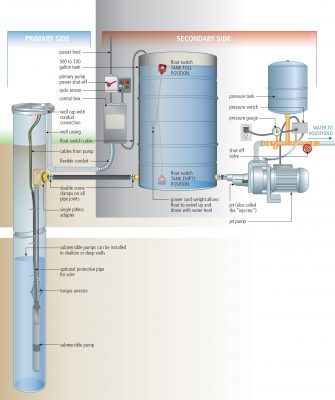
Instead of a pump delivering water directly to a pressure tank that supplies your house, the trickle system has two pumps, each part of the two different sides of the system. The first side – called the “primary side” –draws water from your well whenever it’s available around the clock. This water is stored in an enclosed holding tank (typically about 300 gallons for an average household), either buried in the ground or tucked away in some corner of your basement. You can also use an above-ground tank if you live in an area that doesn’t freeze.
TECH TIP: Keeping Water Pure
Besides the actual creation of a water well system, the main thing is that your well doesn’t introduce contamination into underground aquifers. What’s the point in having a reliable water system if the water makes you sick? In its natural state, groundwater is pure and sterile. But the continued purity of groundwater depends on the amount of time surface water spends percolating down through the earth. That’s why any situation that lets surface water drain immediately into the aquifer, either around or through existing wells, leads to trouble. Created properly, wells are the only source of non-municipal water with the potential to be safe without the need for ongoing sterilization. Keeping an aquifer pure takes diligence, but it’s worth it.
As good as wells are, they’re not always the most practical option. Wells can be expensive to create. Sometimes, in order to penetrate down to usable amounts of water, wells may need to be deep enough that they encounter naturally occurring minerals that cause unpleasant tastes, odor or appearance. These are some of the reasons why people choose to develop surface sources like lakes, rivers and springs instead of wells.
Surface water sources are sometimes abundant in certain locations, but they’re also vulnerable to contamination. That’s why water authorities everywhere consider it essential to treat water from surface sources even if it tests safe. You never know when it might go bad. You’ll also typically have to invest in filters to remove coarse sediments that aren’t present in well water. In cold climates, tapping into surface water sources year-round can also pose a challenge when it comes to keeping water intake lines from freezing. Whether or not your property includes a productive well, it makes sense to develop any surface water resources you have for less exacting uses, such as irrigation and washing vehicles.
The second part of the system – called the “secondary side” – includes another pump that draws water from the storage tank and feeds it into a traditional pressure tank that supplies water to all your taps and fixtures in the usual way. This secondary pump switches ON and OFF automatically as pressure rises and falls in the pressure tank during normal household water use. Since this secondary pump draws water from a large available volume in the storage tank, it’s quite capable of supplying heavy peak loads without running dry. While all this is happening and afterwards, the primary side of the system keeps drawing water from your weak well as it’s available, replenishing the storage tank as this becomes possible, day or night. And make no mistake, the seemingly limited supply of a disappointing well can actually add up to quite a bit of water when taken over a 24 hour period of time, day after day.
Watch the video up next for a deeper understanding of how the trickle system works.
